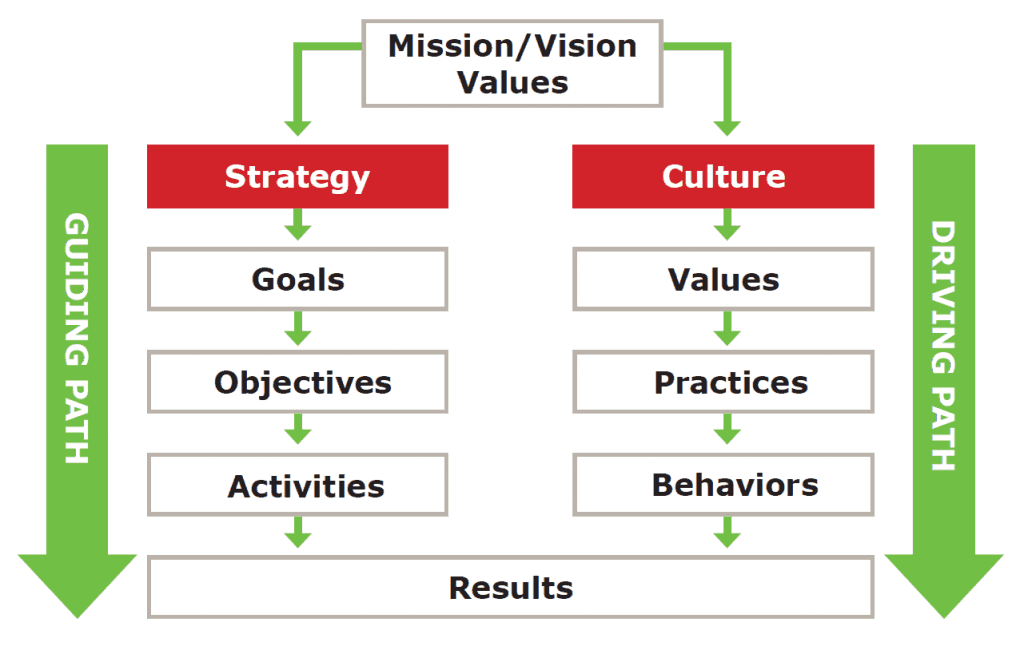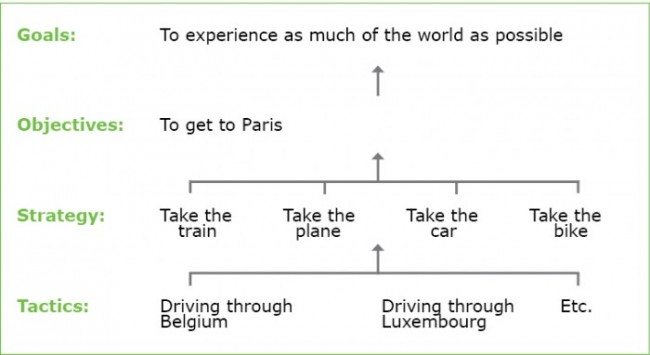Corporate culture need to be in line with strategy
Organisational alignment requires compatibility between the strategic and cultural paths, and consistency within them.
There’s no doubt about it – building organisational alignment is a big challenge. Creating the right organisational alignment is not something that happens by chance and often a great deal of effort and thought goes into the process.
The most important thing about organisational culture is that it’s the only sustainable point of difference for any organisation. Anyone can copy your strategy, but nobody can copy your culture. Culture trumps strategy every time. One could argue that culture in fact is more important than strategy.
Build organisational alignment #1 – How does your strategy looks like in action
Organisational alignment is built on your business strategy so you must begin here. Your business strategy must clearly define your primary value proposition, your future results destination, and the values and behaviors that will guide your actions on the journey to business results achievement.
While this content is important, it is also critical to describe the actions, in the form of strategic objectives, your company must focus on to get from the present to the future destination.
Build organisational alignment #2 – Build an awareness of culture
Organisations often start by clarifying some of the key challenges they have as an organization. Think about frustrations about “the way things work around here” that are holding your organisation back from reaching its potential. It also helps to define strengths you need leverage in support of your strategy as you understand how to further improve your culture.
Build organisational alignment #3 – Measure your culture
Some organisations think they may be covering this measurement through an engagement, climate, satisfaction or other survey but they are actually only evaluating a fraction of the overall culture. Engage your organisation in the process to move from the fog of opinions and lack of clarity about your culture to a clearly defined picture of what you are all about. You’ll understand the overall culture and how it varies by department, division, level, geography or other key sub-groups.
Build organisational alignment #4 – Communicate your strategy
Your organisation/peoplecan’t align with your business strategy if they don’t know what it is. Strategy communications are a critical, ongoing requirement in the drive to build organisational alignment. Communication must be frequent and two-way at all levels of the organization using multiple communication vehicles and a variety of targeted messages. It is important to remember that there is no such thing as over-communication or too much business leader involvement when you are striving to create an aligned organisation.
Build organisational alignment #5 – Cascade your strategy
It is important to cascade strategy vertically and horizontally across your company and define the local actions and contributions each area of your organisation must make to achieve business success.
Build organisational alignment #6 – Define key culture improvements
Engage the organisation in feedback and prioritization to define key culture improvements. Utilize feedback and prioritization techniques to understand your culture assessment results and to identify the top improvements to leverage strengths and improve weak areas that are holding you back. Many organisations obtain feedback but then employees are left wondering what will happen next. The key is prioritization as a team and not just more feedback. It may take voting, debate, focus groups or another simple surveys but prioritization as a team is the key so the organisation feels clearly engaged in the process to define the priorities.
Build organisational alignment #7 – Link all work activities with your strategy
It is necessary to take an inventory of key business processes and projects and determine whether they link to and support the elements of your business strategy. When non-strategic projects and processes are identified, business leaders must seize the opportunity to stop doing them and re-invest organisational work capacity into more strategic work. Making decisions about the strategic value of the work completed in your organisation can make the difference between a more efficient, high performance organisation and one that wastes effort unnecessarily.
Build organisational alignment #8 – Link all employees with your strategy
Alignment at the employee level begins by helping them see how their work links with the business strategy – this makes strategy more meaningful to everyone in your organisation. Next, it is important to let employees know what they need to do in their work to contribute to the overall results. Do this by creating individual goal plans that have clear linkages with your business strategy and provide performance guidelines that will help them move the business forward. Finally, give employees the opportunity to generate and share their insights and ideas on local ideas for improvement that could have a big impact on your business strategy. All of this plays a critical role in solidifying organizational alignment at the employee level.
Build organisational alignment #9 – Measure progress
It will be important to monitor key measures related to the top priorities since culture clearly impacts performance. There will need to be regularly scheduled feedback and prioritization routines to identify and build on what’s working and to adjust actions that aren’t having the desired impact.
Build organisational alignment #10 – How to build a strong culture
Short URL & title:
How to build organisational alignment and performance — http://www.torbenrick.eu/t/r/evg
Share it:
If you enjoyed this article, please take 5 seconds to share it on your social network. Thanks!











I found the article very useful. Thanks.
I appreciate your charts. I think it easy to say, “this is how you improve something, or achieve a goal.” However, using actual examples like you did in your second chart is what really makes that information useful. Thank you for the practical example of how to apply this concept.